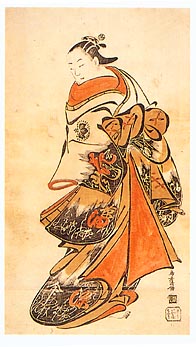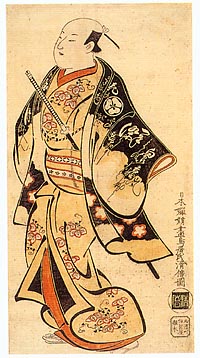Copyright © [Barenforum.org],
2000-2001
Masthead design by John Amoss, Illustration (706)
549-4662 - e-mail: amoss@mindspring.com
No part of this newsletter may be reproduced without
permission from its publishers
To subscribe to Baren-suji, change your subscription
format, or unsubscribe, please go to http://barenforum.org/forum/newsletter/newsletter_sign-up.html
 EDITOR'S NOTES
EDITOR'S NOTES
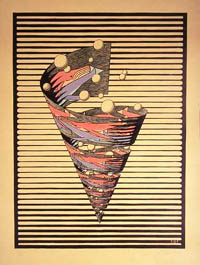 Stream, 1998
Stream, 1998
by Baren Member Hideshi Yoshida
|
|
This Spring brings yet another issue
of Baren-Suji, our newsletter. Contributions from our membership were crucial
in bringing this issue together, and I thank everyone here heartily for
helping.
Sadly, I will not be able to continue as Editor of this fine production.
I am assuming that someone in the ranks of Baren will step up and take
rein of the task of recording our marks. The reasons for me discontinuing
this wonderful task are many and irrelevant; the fact is this will be the
last issue I am able to produce.
Many of you have contributed and your contributions will continue to
be extremely important to the survival of the newsletter. However, someone
is needed to put it all together and make it happen. That someone (and
I have full faith that one of you will take the baton) should have good
working knowledge of HTML or an alternative web page composing program
in order to complete the quarterly task.
Perhaps a budding editor can emerge every quarter and thus give Baren-Suji
a new flavor with each issue. Perhaps one of you is just sitting and waiting
for such a task. In any case, Dear Members, the next issue of Baren-Suji
rests solely and fully in your hands.
Please contact your editor directly or a member of the Baren Council
regarding this matter. Thanks everyone.
"We must, indeed, all hang together,
or most assuredly we shall all hang separately"
-Printmaker Benjamin Franklin
|
A special thank YOU! to the contributors this issue:
|
Bea Gold
|
Barbara Mason
|
Sharen Linder
|
David Bull
|
|
April Vollmer
|
Shireen Holman
|
Matt Brown
|
John Amoss
|
|
Sarah Hauser
|
Ray Hudson
|
|
|
As always, an extra thank you to our friendly Baren graphic
designer,
John Amoss, for the Baren-suji masthead design and the
many logos that keep popping up in the Barenforum web site.
Enjoy!
Maria Arango, Editor of Baren-Suji
Please direct letters to the editor and comments to:
Editor@mariarango.com
Remember that your contributions will continue to make
this newsletter interesting and palatable for all. To contribute a feature
article or an item of interest, please contact: Contribute@mariarango.com
 EXCHANGE, EXHIBITIONS, ACTIVITIES...
EXCHANGE, EXHIBITIONS, ACTIVITIES...
Remember! General information and links to all exchanges
can always be found here: http://barenforum.org/exchange/index.html
And in case you missed them, the Exchange Gallery can delight you
here:
http://barenforum.org/exchange/exchanges.html
Exchange #8 was a non-themed exchange in the larger O-ban size. Your friendly
coordinator this time was Ray Hudson in cold Vermont. Prints have been received
by participants, and are now on display on the website. There is a mechanism for giving the participating
artists feedback on their prints; this makes for good discussion. Check
it out and say what you think by viewing the Exchange Exhibit in the web
site.
Exchange
#9 is well on its way, prints are due May 1st, 2001. Mark your
calendars! This is a smaller size themed exchange with the concept of "Endangered
Species." The collection promises to be interesting!
And as usual, another exchange is around the corner. Be sure to keep
checking the dates and mark your calendars for the upcoming sign-up period
of Exchange #10. A great way to keep up with these is to bookmark the Exchange
sign-up pages in your Favorites or Bookmarks (Internet Explorer and Nescape
respectively).
The Baren
International Swap Shop is officially working, James Mundie presiding.
The first batch of prints has been received by the participants and can
be seen here: http://barenforum.org/swapshop/intro.html
For those of you that wish to participate in a smaller and less pressuring
exchange, go to the woodblock site and read all about this new Baren program.
We hope that you will also encourage non-members to participate so that
we can promote the traditional exchange of prints among printmakers throughout
the world.
Woodblock Print Lecture/Demonstration
Last February 27th Baren members Julio Rodriguez and Sharen Linder combined
forces to give a talk/demo on woodblock printmaking. The audience of approximately fifty artists
were members of the Skokie Art Guild, a long standing community group consisting
of over 100+ painters, photographers and sculptors.
Julio started the hour and a half presentation by defining the word
"print", defining the challenges of printmaking and the why's, and followed
with a detailed explanation of the differences between the western and
the Japanese styles of woodblock. Also covered were the closely related
wood engraving and linoleum block techniques. Both Sharen and Julio brought
along many of their own prints to share with the group as well as a selection
of exchange prints from other Baren members. An assortment of tools and
materials were on display and Julio described and demonstrated their use
in traditional woodblock printmaking. Among the things that the audience
got to see was a set of three woodblocks carved by our very own forum founder
David Bull. Plans are in the works for a workshop in the near future.
BAREN Woodblock Print Exhibition
The second annual BAREN woodblock print exhibition will be held again
this year at the Skokie Public Library. Last year Baren member Julio
Rodriguez exhibited his collection of Baren exchange prints and also invited
artists.
In total the exhibition included over 130 prints representing seventy-five
international members.
This year's exhibition will open on May 20 and go through the first week
of July. Because the space available this time is limited to only the first
floor area, the exhibit will include only a selection of prints from exchanges
#5 through #9 and postcard prints from the very popular New Year Snakes
exchange. As the date approaches, Julio will post more information
and details about the exhibit and the selection of prints going on display.
Last year's exhibit can be viewed here: http://www.skokienet.org/bandits/jcrstuff/libphotos.html
BAREN Exchange Print Exhibition May 20 - July 3, 2001
Skokie Public Library
5215 Oakton
Skokie, Illinois 60077
(847- 673-7774) www.skokie.lib.il.us
If you are missing out on the exchanges and
exhibitions, be sure to tune into the Baren
forum and take a gander through the Encyclopedia. Opportunities abound
and await!
 GROWING A BAREN EXHIBIT
GROWING A BAREN EXHIBIT
written by Bea Gold with contributions by Julio Rodriguez
Since our first Baren Exhibit, I have watched with interest
the exhibits that have been developed around the world. I felt challenged
to try to get one in this wild and wonderful town, Los Angeles.
I chose the Los Angeles Public Library, because it is centrally located,
has the respect of the community and is beautiful and has a lot of daily
traffic.
Toria Aiken (the Central Library Exhibition Coordinator) and I began
an email communication in late 2000. Toria is a very busy but interested
and interesting person and finally after several emails back and forth,
we were able to meet on March 1st at the library. I brought Baren
Exchanges 2, 4, 5, and 7 as well as both my Dragon and Snake prints.
I also brought a set of cut blocks (my #4 exchange self portrait), some
bushes, cutting tools and a baren. Toria asked Library Designer
Carol Fulton to join us and we went through the prints. I showed
and described the use of the other things I brought. They studied
each print as they were turned up with much interest and then we talked
about what other displays and activities they would like in addition to
the hanging of prints. I recognized many of the artists as we turned
over the prints and felt very good about that. They expressed interest
in three presentation/demonstrations geared towards the different age groups
the cater to: Children, Teens and Adults. I thought I might be able
to get L.A. people Ruth Leaf and Georga Garside to each do part of it.
They wanted a case holding the tools of woodcuts to make a “How To” display.
We talked about where other Baren Exchange exhibits had been held
and what they were like. I left feeling like we would definitely
have an L.A. exhibit BUT we did not set a date for a follow up meeting
and have not heard from Toria! Will it happen? Check the next
Baren Suji for an update on the L.A. Public Library, Baren Exchange Exhibit.
Julio Rodriguez put this impressive list together, you might call
it Baren's own Resume:
BAREN EXHIBITS since inception to present (and future!):
Third KIWA (Kyoto International Woodprint Association) Exhibition, Kyoto,
Japan - June 1999. Organized by: Richard Steiner.
"Baren Print Portfolio", Manhattan Graphics Center, Manhattan, New York
- October 1999. Organized by: Judy Mensch, April Vollmer, Sarah Hauser, Ray Hudson.
"Baren Exchange Print Exhibit", Skokie Public Library, Skokie, Illinois
- April/May 2000. Organized by: Julio Rodriguez, Sharen Linder.
"Junin-Toiro - Ten People, Ten Colors", National Art Gallery ( Nommo
Gallery ), Kampala, Uganda - May 2000. Organized by: Greg Robison.
"Woodcut Prints.com", Beit Gavriel Cultural Center, Jordan Valley, Israel
- November 2000. Organized by: Arye Saar.
"Baren's 6th Print Exchange Exhibit", Kent State University's Geauga
Campus Gallery, Burton, Ohio - November 2000. Organized by: Gayle Wohlken.
"Woodcut Prints.com", Yad leBanim Gallery, Tiberias, Israel - January
2001. Organized by: Arye Saar.
UPCOMING EXHIBITS:
"Baren Print Exhibit", Skokie Public Library, Skokie, Illinois - May/June
2001. Organized by: Julio Rodriguez.
"Endangered Species", Artists Unlimited, Florida Printmakers Society,
Tampa, Florida - August 2001 (?) Organized by: Daniel Dew.
Hats off to the members who have volunteered their valuable
time, resources, and sometimes money to achieve these international exhibits
and demonstrations of the art of the woodcut.
 Southern
Graphics Conference Reports: 3 Perspectives
Southern
Graphics Conference Reports: 3 Perspectives
by April Vollmer, Barbara Mason, and Shireen Holman
April Vollmer's Report
Southern Graphics Council Meeting in Austin, March 8 to 10, 2001
Printmaker’s Gossip Column
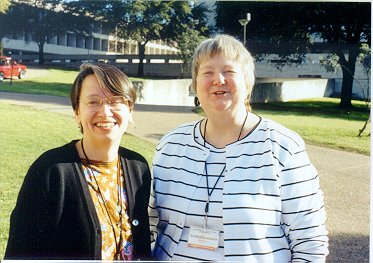 This
was the first time I had gone to this important printmaking conference.
I had heard about it for years, it has a reputation as a great place to
meet fellow printmakers and to get inspired about printmaking.
This
was the first time I had gone to this important printmaking conference.
I had heard about it for years, it has a reputation as a great place to
meet fellow printmakers and to get inspired about printmaking.
The first reason I decided to go this year was that many printmakers
I’d met at when I taught a hanga woodcut class at Frogman’s Print and Paper
in South Dakota last summer would be there. The second reason was that
many printmakers I knew from Baren would be there. The clincher was that
Barbara Mason offered to arrange the hotel, and Susan Rostow offered to
arrange the flight. All I had to do was show up.
Seeing old friends was the best part of the conference. Barbara Mason
and Shireen Holman are not exactly old friends--we had never met before.
But they certainly FELT like old friends, since we have known one another
at Baren for several years now. Sharing a room with the energetic, positive
force called Barbara Mason and the quiet, serious cutter of exquisitely
patterned books, Shireen Holman, was a highlight of the conference. It
was also great to spend time with Susan Rostow (the clever co-inventor
of Akua Color), and a pleasure to meet her friends Gail and Julia Ayres
(clever inventors of the printing pin). I felt guilty sometimes because
I missed so many nice talks and demonstrations...but then I realized I
was doing the most important thing: chatting with other printmakers.
For woodblock printers our own Karla Hackenmiller's demo was a treat.
She worked with Nancy Palmieri,  another
great block printer I hadn't met before, and of course the inimitable Tom
Huck with his eight-foot black and white cuts. I found Bareners Roxanne
Sexauer, Bobbie Mandel, and a lurker or two were all enjoying that demonstration
too. The steamroller print demos were fun, though the prints showed more
energy than finesse. It was a thrill to be in a place with 800 enthusiastic
printmakers and to overhear stories about various esoteric printerly subjects
that you might only expect to hear in the dark recesses of a printshop
in the elevator of the Omni Hotel. Chicago artist Tony Fitzpatrick's keynote
address was inspiring, he spoke about the importance of printmaking, he
has dedicated much of his creative energy to funny, personal, and very
idiosyncratic small color etchings.
another
great block printer I hadn't met before, and of course the inimitable Tom
Huck with his eight-foot black and white cuts. I found Bareners Roxanne
Sexauer, Bobbie Mandel, and a lurker or two were all enjoying that demonstration
too. The steamroller print demos were fun, though the prints showed more
energy than finesse. It was a thrill to be in a place with 800 enthusiastic
printmakers and to overhear stories about various esoteric printerly subjects
that you might only expect to hear in the dark recesses of a printshop
in the elevator of the Omni Hotel. Chicago artist Tony Fitzpatrick's keynote
address was inspiring, he spoke about the importance of printmaking, he
has dedicated much of his creative energy to funny, personal, and very
idiosyncratic small color etchings.
The materials fair was almost as much fun as the main conference. Susan
Rostow gave ongoing demonstrations of Akua Color ink, and I found Barbara
Mason pulling a print or two with her in between lectures. I hear Dean
from Graphic Chemical was there, but I was too busy! I did have an opportunity
to talk with Hiromi, the intrepid Japanese paper importer from Santa Monica.
I got some new washi samples to try from her. There were other paper suppliers,
inks, digital materials, the printing pin, and perhaps the most tempting
of all, Chapter Registration for THE HONORABLE COMPANY OF GENTLEMAN PRINTMAKERS
SOCIAL CLUB. For only $10 I could have started my own chapter! I was politely
assured that ‘gentleman’ includes both sexes. They had buttons and certificates.
But alas, I missed my big opportunity. Does anyone know where the central
offices are?
Next year the Southern Graphics Council meets in New Orleans, the following
year in Boston, and then at Rutgers. Check http://www.utc.edu/~utcsgc/frmaing.html
for more information.
Barbara Mason's Turn
There is not a lot I can add to April's overview of the conference,
we had a great time and although we were pretty tired of box lunches by
the end, I think we would all go again. I did have a chance to meet with
Dean Clark and his daughter Sarah, both such nice people and both doing
so much to promote printmaking. I finally got some tubes of their water
soluble block printing ink so will report on it as soon as I have an opportunity
to try it.
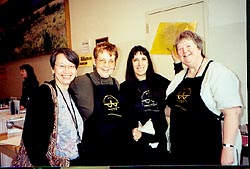 Less
toxic processes were not as big an issue this year, but everyone assumes
the world in general is moving in that direction. Karla Hackenmiller
demonstrated her carving on 1/8" HIPS or high impact polystyrene. She carves
it with woodcut tools and inks it with oil based litho ink. Pictures will
appear somewhere, if not here then on the show and tell pages. I don't
think it will replace wood, but it was very interesting.
Less
toxic processes were not as big an issue this year, but everyone assumes
the world in general is moving in that direction. Karla Hackenmiller
demonstrated her carving on 1/8" HIPS or high impact polystyrene. She carves
it with woodcut tools and inks it with oil based litho ink. Pictures will
appear somewhere, if not here then on the show and tell pages. I don't
think it will replace wood, but it was very interesting.
We saw a lot of artwork and came away inspired to go home and work in
our studios. Shireen's books were twice as amazing in person and April's
beautiful and large hanga prints were truly inspiring. April said she had
trouble with the bokashi printing, but it looked to me like she had it
down pretty well. I hope I can take a class from her some time in the future
to hone my skills a bit.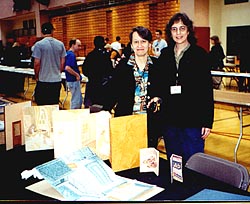
Meeting old friends and making new ones, what could be better? All with
an interest in printmaking, it was like heaven. The only problem was not
being more than one person so I could see everything. As usual many things
were happening at the same time. Guess this means we will have to go again!
The steam roller printing was great, lots of enthusiasm and prints that
turned out fairly well considering the problems inherent with such a large
project. Pictures to follow....
And Shireen Holman's View
BORDER CROSSINGS, THE SOUTHERN GRAPHICS COUNCIL’S 29TH ANNUAL CONFERENCE
By Shireen Holman
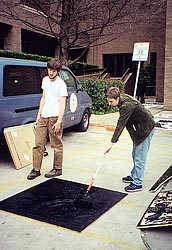 In
March, I flew down to Austin, Texas, to attend Border Crossings, the Southern
Graphics Council’s 29th Annual Conference. The conference was hosted by
the art department of the University of Texas at Austin, and was organized
by Tom Druecker and Margie Simpson. It was a wonderful conference – my
only regret is that, being only one person, I could only attend one event
at a time. I went to many interesting and stimulating demonstrations and
presentations, but felt that I missed even more than I saw!
In
March, I flew down to Austin, Texas, to attend Border Crossings, the Southern
Graphics Council’s 29th Annual Conference. The conference was hosted by
the art department of the University of Texas at Austin, and was organized
by Tom Druecker and Margie Simpson. It was a wonderful conference – my
only regret is that, being only one person, I could only attend one event
at a time. I went to many interesting and stimulating demonstrations and
presentations, but felt that I missed even more than I saw!
The University of Texas campus is huge. I think we all got plenty of
exercise the few days we were there, scurrying from one place to another.
Spring had arrived in Austin, with flowers in bloom everywhere – a nice
change from the snow and freezing rain we’d been having in Maryland. I
had been looking forward to hearing Barry Moser speak on Thursday, March
8th, but it turned out that he had been unable to come because of snowbound
airports in New England! However, I was glad to be able to see his video,
“A Thief Among the Angels,” which documents his work on the Pennyroyal
Caxton Bible. About a year ago, I had seen the Bible with its intricate,
brooding wood engravings, at the National Gallery of Art in Washington
D.C. It was on exhibit at Concordia University in Austin during the conference.
 Every
day there were panels and speakers; a section called “Telegraphics,” which
consisted of videos about printmaking; a section called “Demographics,”
a collaborative project involving photo-litho, ink-jet transfers and monoprints;
demonstrations of various printmaking techniques; an ongoing bookmaking
project; and the product fair. In addition, on Thursday evening there were
buses to area galleries and print workshops, on Friday evening there was
an open portfolio, and on Saturday evening there was a Texas barbecue and
wrap-up party.
Every
day there were panels and speakers; a section called “Telegraphics,” which
consisted of videos about printmaking; a section called “Demographics,”
a collaborative project involving photo-litho, ink-jet transfers and monoprints;
demonstrations of various printmaking techniques; an ongoing bookmaking
project; and the product fair. In addition, on Thursday evening there were
buses to area galleries and print workshops, on Friday evening there was
an open portfolio, and on Saturday evening there was a Texas barbecue and
wrap-up party.
For me, the demonstrations were the real highlight of the conference.
Michael Krueger, Lisa Bulawsky, Adele Henderson, Bob Anderson and Eileen
Foti worked together on the Demographics project. Observers were able to
participate by working directly on the images being developed. I was fascinated
to see the changes in the prints from one day to the next. In between dropping
in on Demographics, I watched several of the other demos. Oscar Gillespie
demonstrated metal plate engraving and showed his beautifully detailed
portraits. Donald Furst gave a hilarious talk about the serious and exacting
technique of mezzotint. Wearing a hat (?!) made out of his daughter’s basketball
with a large cardboard mezzotint rocker attached to the top, he explained
how to create velvety blacks and subtle gradations of grey. He talked about
both why one might want to use a 350-year-old traditional method, and how
to create “faux” mezzotints using modern techniques. Charlie Jones also
gave an interesting and informative demo of large woodcut techniques. His
work is printed from pine planks up to 72” long, which have been glued
together to give a width of 24”. Sometimes he uses power tools to cut the
blocks into shapes. He prints by hand, using drawer pulls.
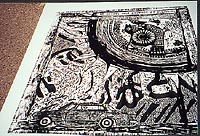 Other
relief demos included methods of creating chiaroscuro, by Nancy Palmeri;
black-line woodcut techniques similar to those Dürer used, by Tom
Huck; and engraving techniques on Hi-impact Polystyrene, Sintra and Resingrave,
by Karla Hackenmiller. The steamroller printing, done outside on a driveway,
was more of a fun event than anything else. House paint rollers, dipped
into buckets of ink, were used to ink up large, roughly carved blocks.
Four people were needed to lay the paper down. The steamroller then rolled
over the paper, first forward and then backwards.
Other
relief demos included methods of creating chiaroscuro, by Nancy Palmeri;
black-line woodcut techniques similar to those Dürer used, by Tom
Huck; and engraving techniques on Hi-impact Polystyrene, Sintra and Resingrave,
by Karla Hackenmiller. The steamroller printing, done outside on a driveway,
was more of a fun event than anything else. House paint rollers, dipped
into buckets of ink, were used to ink up large, roughly carved blocks.
Four people were needed to lay the paper down. The steamroller then rolled
over the paper, first forward and then backwards.
One of the most interesting gallery exhibits was the work of North Vietnamese
artist Dinh Luc. He had been invited to do a guest residency at The University
of Texas as part of the SGC theme of Border Crossings. Artist Gordon Fowler,
a Purple Heart Marine from the Vietnam War, had met him when he returned
to Hanoi last year for a visit. Fowler explained, rather incredulously,
that the two had been soldiers fighting on opposite sides in the same part
of Vietnam at the same time. Now they were collaborating on the exhibition.
Dinh Luc uses water-based inks on black paper to create large textural
cityscapes and scenes from folktales.
The Printmaker Emeritus Award for 2001 was given to Antonio Frasconi.
There was also an exhibit of his work on campus. The Slugfest Printmaking
Workshop and Flatbed Press both have impressive printshops and equipment,
as well as very nice gallery spaces. The Slugfest Gallery had an exhibit
of Tony Fitzpatrick’s work. Unfortunately I missed the talk he gave – several
people described it as very inspiring.
Meeting other printmakers and exchanging ideas is a very important part
of the experience of attending the conference. I met many new printmakers
and also connected with friends from around the country whom I had not
seen in many years. I couldn't believe my luck to be rooming with Barbara
Mason and April Vollmer! We turned out to be very compatible, and even
enjoyed going out to get a taste of Austin's active nightlife. (When we
returned to our hotel after midnight, we had to walk around the block,
trying all the doors, before we found an entrance that was unlocked). The
open portfolio was also an excellent opportunity to meet people, to show
work, and to see what others are doing.
Next years conference will be held in New Orleans. We all came away
from Austin wearing brightly coloured Mardi Gras beads promoting “Print
Gumbo” in New Orleans.
 THE
DYNAMIC DUO: April Vollmer and Sarah Hauser Baren Members
THE
DYNAMIC DUO: April Vollmer and Sarah Hauser Baren Members
by Bea Gold
It has been a very interesting to read about the interactions, quest to learn and successes (and failures) of Baren Members. We
live in so many different environments including farms (Wanda shearing
sheep in Oregon) and cities, (Nilsa’s workspace problem in Manhattan) and
forests (Gayle in an Ohio woods ) and deserts (Maria in Las Vegas).
We come from many countries including Brazil, Greece, Mexico, Japan, Israel,
Bulgaria, Canada, England, United States, Ireland, Australia, Uganda (what
did I miss?) we work alone in studios or are teaching or attending
art schools and universities, surrounded by people. We have our youngest
member, 11 year old Meagan Dew and our oldest ones (I know a couple in
their 70’s) How many of us have met face to face? How many of us
have had Teacher/Student relationships?
In this issue we will concentrate on two very successful New York artists
whose relationship has grown before our eyes.
April Vollmer http://www.aprilvollmer.com
Sarah Hauser http://www.sarahhauser.womanmade.net
Both April and Sarah were asked a number of questions to help draw a
picture of their relationship as it has 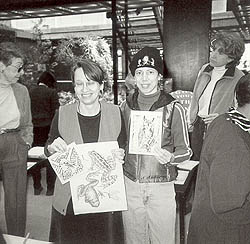 developed
over time. Each responded with such ease that I found myself envying
their experiences. Well, we may not be able to live them but we can
get vicarious enjoyment from reading descriptions of their learning, teaching,
volunteering and exhibiting. When asked: “How did you first
get interested in relief printing and in hanga in particular? And How did
you meet?” We learn that both April and Sarah came to hanga after
many experiences with other forms of printmaking. April has her MFA
in printmaking and always had a special affection for woodcut as the most
basic and sculptural of the printmaking techniques. She worked with
oil based inks. Sarah’s first prints were monotypes and linocut prints
and combinations of types of printmaking that can be done without a press.
developed
over time. Each responded with such ease that I found myself envying
their experiences. Well, we may not be able to live them but we can
get vicarious enjoyment from reading descriptions of their learning, teaching,
volunteering and exhibiting. When asked: “How did you first
get interested in relief printing and in hanga in particular? And How did
you meet?” We learn that both April and Sarah came to hanga after
many experiences with other forms of printmaking. April has her MFA
in printmaking and always had a special affection for woodcut as the most
basic and sculptural of the printmaking techniques. She worked with
oil based inks. Sarah’s first prints were monotypes and linocut prints
and combinations of types of printmaking that can be done without a press.
April looked for someone to teach her the Japanese method of printmaking
and found . Kathy Caraccio who offered an introductory class. Kathy
Suggested she call Bill Paden, a real expert, who had lived in Kyoto for
many years. He became April’s teacher and guided her to a deeper
understanding of the technique with an intensive series of private lessons.
Sarah also had a desire to learn the Japanese method and in 1997, found
a class in Japanese woodblock printing, at Manhattan Graphics, taught by
Jonathan Glick. After this class Sarah studied with Kathy Caraccio,
who gave her many new things to try with this technique. She recommended
that Sarah take a class with April Vollmer, which she did at the Lower
East Side Printshop. As they say in the movies – “The rest is history!”
Sarah states that April helped answer so many questions about the many
different aspects of hanga, from cutting wood to tool sharpening to printing
that she helped Sarah move up to a whole new level of printmaking.
The more she learned about hanga and woodblock printing, the more she felt
she still had to learn. Sarah states that as time has gone on, April and
she have continued to share opportunities, and April has been continually
generous as a teacher and as a friend.
“Teacher April” describes Sarah as an advanced student who zoomed ahead,
bringing in more complicated blocks each week. She sets herself insurmountable tasks and then
surmounted them. She had bought good tools, and was Aprils model
student, providing great demos for the other students. They worked
on the Baren show at Manhattan Graphics together with Judy Mensch.
Sarah submitted a proposal for a two person show to Organization for Independent
Artists and the proposal was accepted. April and Sarah were the two
persons! Sarah did the organizing, and they worked together on the
hanging and opening. It was great to see how the two styles fit together.
They share a strong feeling for pattern and a sense of humor in their approach
to animals
blocks each week. She sets herself insurmountable tasks and then
surmounted them. She had bought good tools, and was Aprils model
student, providing great demos for the other students. They worked
on the Baren show at Manhattan Graphics together with Judy Mensch.
Sarah submitted a proposal for a two person show to Organization for Independent
Artists and the proposal was accepted. April and Sarah were the two
persons! Sarah did the organizing, and they worked together on the
hanging and opening. It was great to see how the two styles fit together.
They share a strong feeling for pattern and a sense of humor in their approach
to animals
( http://www.aprilvollmer.com/patterned/crawl.html )
The exhibition went well with a lively and well-attended opening, very
positive feedback.
Sarah and April found that they had a lot in common, and Sarah went
to April’s studio for a little private consultation. April visited
Sarah's to see her blocks, and gave one-on one lessons which were extremely
helpful. Sarah asked her how she could repay her, and April said
she could help her tote her printing equipment out to Brooklyn for a hanga
demonstration at the yearly Sakura Matsuri (Cherry Blossom Festival) in
the Brooklyn Botanic Garden. Sarah found this much more a treat than
a chore and this year will be the third year doing this demo together.
They find the festival hectic and crazy and wonderful all at the same time.
It is an opportunity to demonstrate basic Japanese printing to the general
public and requires patience, printing simple blocks all weekend.
Being outside with a crowd leaves little time to discuss the finer points
of hanga, and the same information must repeated to a changing group of
visitors. All kinds of people from children to artists to housewives,
stop by to watch the Printmaking. It looks like magic to children.
Sarah says ”They watch intensely in anticipation as you rub the back of
the paper with the baren and often cheer as you pull the paper up off the
block to show them”. At the next Sakura Matsuri Sarah will be officially
on the program. Wearing her plastic monkey earrings, while interacting
with the children.
While working at the Sakura Matsuri, April met the Executive Director
of the Japan Society who invited her to give a class for twenty New
York City school teachers. They could learn about the culture of
Japan by creating a print themselves. April prepared written material
and did the talking to the group at large, while Sarah circulated around
helping individuals. She spent her time going around to each student,
making sure they had their kentos cut right, and their paper face down.
The people at the Japan Society were enthusiastic about the idea of doing
it again sometime, as well as possibly having them do a demonstration in
their summer festival.
The future holds some exciting prospects, Sarah has a show coming up
in Chicago while April has one at the same time in New York. They
wont be able to support each other at the big openings but they will continue
to find projects to work on together, and will continue to share information
and support. April says, “One of the greatest things about doing
crazy things like Japanese woodcut, is the conspiratorial pleasure of sharing
an obsession with someone as generous as Sarah Hauser” and Sarah says,
“It's always a pleasure working with April, I feel our personalities complement
one another, and she's a great teacher and great human being!”
 A
HIGH/LOW PRINTING/CARVING ENSEMBLE
A
HIGH/LOW PRINTING/CARVING ENSEMBLE
by John Amoss
I have been looking at different solutions for hanga
style printing desks the last few years. Initially, I used a drafting table
which I think was perfectly useful, but I never felt like I could stand
for hours on end and that I needed to sit down and let my arms do the work.
I therefore started considering low desks- the traditional Japanese
style such as David
Bull uses in which the printer and carver sits on a floor cushion.
I'm not a naturally flexible person, but I jury-rigged a similar desk using
books and a piece of wood to try things out. After about 15 minutes of
working on the floor, I realized that this was not something I could ever
get used to.
I was then reminded of Baren member Matt
Brown using a compromise- sitting on a low stool that allows for what
I thought might be the best of both worlds: a "settled" sitting position
and yet ergonomically comfortable.
You might look at the images here and say I'm complicating things and
making a piece of furniture- which is probably true! My enjoyment of woodworking
led me to woodblocks and I love projects that include both pursuits. My
objective in sharing these plans is for you to take what you see here and
simplify things to suit your needs. An example: I used solid oak and brass
fittings; you don't need to of course, 3/4 inch plywood and deck screws
would work just fine. For the paper tables, simple boxes would also do.
If you are interested in making a bench like this, I would suggest that
you make a makeshift version using materials like books, cardboard or cheap
pieces of wood. Variables such as leg length, flexibility, size of prints,
angle of desk, etc. make for a wide range of possibilities. As a result,
I wouldn't follow my specific measurements but would suggest that you arrive
at what dimensions you deem are appropriate.
[click to enlarge]
front view 

 not in use
not in use
side view
This ensemble is made up of three parts: (1) the Maebako -
paper to be printed table (2) the Yoko-ita - printed paper table, and the
(3) Suri-dai/Horo-dai - the main printing and carving bench. I also am lucky
to have an old silverware chest in which I store my tools and place my
pigments on top when printing. In addition, I sit on a simple 9" high
stool.
The main bench (as well as the tables) is at a 9 degree slant,
the working surface of my bench is 19" by 30"; the printing side is 14"
off the ground, the carving side is 11". When printing, I have found it
helpful to have the surface slant away from me as traditional benches do.
Once I tried this for a while, it felt right and is supposed to help you
apply pressure more evenly.
As for the carving side, I have bored 2 tapered holes to accommodate
bench dogs. These tapered plugs allow the block to have points of resistance
when carving. Adding a screw makes for a very tight fit and keeps the dogs
from straying. Also, since the surface is at an angle, I added a brass
strip to the lowest edge so that my tools won't fall off and stick me or
worse, get damaged.
One of the most important qualities of a bench is for it to be rock
solid - no sliding on the floor, no rocking, etc. and so I over-built
it. However, I also wanted the bench to be broken down, so I used a wooden
peg to allow for disassembly of the legs and to tighten any looseness in
the joint. I also added a set screw for strength.
This setup differs from any other I've seen in that all of the work
surfaces here (bench, and both tables) are at the same 9 degree angle.
That allows for the paper to stay at a consistent angle - this is a pretty
minor point, but I like not having to tilt the paper as it is processed.
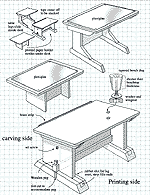 As
for the paper tables, I wanted them to nestle into the printing bench.
The paper to be printed table's leading edge overlaps the printing desk
so that it can be adjusted front or back. Also, since I work with my back
to a wall, I can slide the printing bench away from me when I get up without
disturbing anything. To keep moisture from escaping from the paper into
the table's wood, each paper table has a piece of plexiglas on the top
.
As
for the paper tables, I wanted them to nestle into the printing bench.
The paper to be printed table's leading edge overlaps the printing desk
so that it can be adjusted front or back. Also, since I work with my back
to a wall, I can slide the printing bench away from me when I get up without
disturbing anything. To keep moisture from escaping from the paper into
the table's wood, each paper table has a piece of plexiglas on the top
.
My choice for finishing was a reddish mahogany oil-based gel stain to
minimize the oak's grain and then I followed up with 3-4 coats of yellow
varnish roughing with fine steel wool after each coat including the last
which gave the finish a matte look.
I'm happy with how they came out both in looks and in performance. I
really feel "planted" once I'm situated - much like I'm in a fighter pilot's
cockpit and can work for hours with everything within reach. In retrospect,
however I think that the carving side is a bit low and I wish that I had
made the whole ensemble a little higher, but not by much.
As for cost, it was a little over $100 with a some varnish left over
for sealing my blocks.
I encourage anyone who is interested in asking me more questions
or comments on the bench, please message
me
or we can discuss it on Barenforum.
Thanks to: David Bull and Matt Brown for their input.
© 2001 www.barenforum.org
 "Primitives":
A Brief Look at Early Japanese Prints
"Primitives":
A Brief Look at Early Japanese Prints
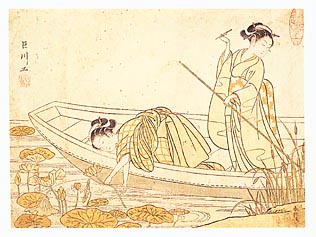 In
reviewing one of the many books of prints that sits in my ever growing
library, I was struck by the simplicity of line and style of some of the
earlier works of Japanese masters. I investigated a bit in order to account
for the black lines, elegantly alone, or sometimes accompanied meagerly
by a splash of color in a very limited palette of golds, greens and reds.
Later, of course, the beauty of Japanese prints lies in the masterful use
of color enhancing but not overwhelming the delicate and efficient designs.
In
reviewing one of the many books of prints that sits in my ever growing
library, I was struck by the simplicity of line and style of some of the
earlier works of Japanese masters. I investigated a bit in order to account
for the black lines, elegantly alone, or sometimes accompanied meagerly
by a splash of color in a very limited palette of golds, greens and reds.
Later, of course, the beauty of Japanese prints lies in the masterful use
of color enhancing but not overwhelming the delicate and efficient designs.
Why the lack of color in early works? Were full color techniques not
known? Were pigments not available? The answer to my query came in a book
by James T. Ulak, published by the Art Institute of Chicago and called
simply Japanese Prints. What follows is a small excerpt from this
book.
"Primitives" is the generally accepted English term for Japanese
woodblock prints produced between approximately 1660 and 1765. (The later
date marks the advent of full-color, multiple-block printing.) The term
primitive
unfortunately connotes both a naive approach to subject matter and limited
technical expertise--neither is an accurate description of the Japanese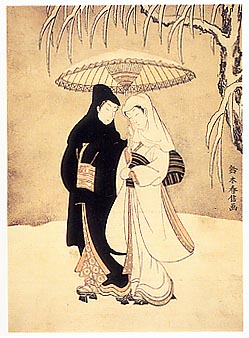 prints so designated. The term is best understood as a category comprising
the three types of works made before the advent of full-color printing:
ink-monochrome, ink-monochrome with hand-applied color, and ink-monochrome
elaborated by a very limited, block-produced palette consisting of green,
yellow, orange, and rose.
prints so designated. The term is best understood as a category comprising
the three types of works made before the advent of full-color printing:
ink-monochrome, ink-monochrome with hand-applied color, and ink-monochrome
elaborated by a very limited, block-produced palette consisting of green,
yellow, orange, and rose.
The dramatic increase in literacy among the general
population in the seventeenth century generated a demand for inexpensive
reading material, sometimes with illustrated texts. At the same time, urban
life in Kyoto, Osaka, and Edo burst with vitality and prosperity. Many
chose to celebrate the new era with panoramic cityscapes, taking delight
in rendering minutely detailed presentations of diverse urban activities,
including the diversions of the pleasure quarters. Gradually, these pleasure
quarters and their denizens became a singular focus for some painters.
What is sometimes interpreted as naive, in
both the paintings and the prints of this period, was probably an accurate
representation of the ebullient and self-satisfied spirit of the times.
Some painted images of courtesans or actors were translated into woodblock
prints. Productions ranged from cheap and casual to carefully printed,
with erotic images especially favored. These ink-monochrome prints were
not a mode of expression languishing in the background until an economical
process for full-color production could be discovered. In a culture in
which the calligraphic brush stroke was regarded as the most sophisticated
art, prints were judged by their ability to approximate the calligraphic
line or reveal the unique textures of ink on paper. The so-called "primitives"
had a devoted following of patrons and connoisseurs.
Prints from top to bottom right:
- Suzuki Harunobu (1725-1770).
Gathering Lotus Flowers, 1765. 8 1/8 x
10 7/8 in. (20.6 x 27.6 cm).
The Crow and the Heron, c. 1765. 10 3/4
x 7 3/4 in. (27.3 x 19.7 cm).
- Tori Kiyomasu I (active c. 1696-1716).
Fujimura Handayu as a Woman, c. 1715. 22
x 12 5/8 in. (55.9 x 32.1 cm).
Dekijima Shogoro, 1715/16. 22 3/8 x 12
1/4 in. (56.8 x 31.1 cm).
 OPPORTUNITIES FOR PRINTMAKERS
OPPORTUNITIES FOR PRINTMAKERS
MORE WORKSHOPS:
Ray Hudson will be teaching a week-long workshop on woodblock
watercolor printing (shui-yin) at Fruit of the Trees Studio in Lincoln,
New Mexico.
Dates are May 21 through 25
Contact Ray Hudson rhudson@together.net
or Beverly Wilson at 505-653-4699 fruitofthetrees@softhome.net.
More information at the Fruit of the Trees Studio http://www.fruitofthetrees.com
ORGANIZATIONS FOR PRINTMAKERS:
If you happen to be a moonlight wood engraver, I turn your
attention to the Wood Engraver's Network.
Since 1994 WEN is an organization for the education and enjoyment of
relief printmaking and, in particular, engraving upon end-grain wood.
WEN offers the delicate and engaging Block & Burin, a quarterly
newsletter (soon to be semiannual) filled with wood engraving history and
wisdom. Members design the cover and it is always a beautiful surprise.
Members also exchange prints, called Bundles, on a quarterly basis.
Membership information can be found at WEN's new and improved web site:
http://www.woodengravers.net
The forum for wood engraving is here:
http://www.egroups.com/group/woodengravers
EXHIBITIONS AND CALLS FOR ENTRIES:
The Florida Printmakers
Society and Artists Unlimited present our very first, International,
“theme” juried exhibition! Every year we will present to the printmaking
world an opportunity to create a print or series of prints based on a “theme”.
This years theme is: Endangered Species. The competition is open to all
the printmakers of the world who have created a work (see eligibility)
in the past three years along the parameters of this “theme”. Whether it
be animal, vegetable, real or imagined, let your imagination and ink flow.
Eligibility:
Works considered for acceptance will be executed in the following media,
or combinations thereof: Intaglio, Relief, Screen Prints, Hand-pulled Lithographs,
Collographs, Monoprints. Reproductions of work created in another media
will not be accepted.
Details:
http://www.printmakersociety.com/NewsEvents.htm
U.S. PRINT EXHIBITS- Courtesy of Baren Member Sharen Linder
MAKING PRINTS: How'd They Do That!?
March 30-April 22
6th Annual Student Printmakers' Competition
April 27-May 17
BIRDS OF A FEATHER:
Avian Prints from the Turner Collection" Exhibition
Ending Date: 03/19/2001
Janet Turner Print Gallery
California State University, Chico
400 West First Street
Chico, CA 95929
http://www.csuchico.edu
GEORGES ROUALT: MASTER PRINTMAKER
FEBRUARY 18 - MARCH 18, 2001
Snite Museum of Art,
University of Notre Dame Campus.
Notre Dame, Indiana
http://www.nd.edu/~art/new_site/index.html
A WRITER'S VISION:
Prints and Drawings by Günter Grass
February 17 to April 15, 2001
WISCONSIN ARTISTS AND THE PRINT RENAISSANCE
February 10 to April 8, 2001
VIRTUAL TOUR Available
Elvehjem Museum of Art
University of Wisconsin
Madison, Wisconsin
http://www.lvm.wisc.edu/index.html
SIX CONTEMORARY JAPANESE PRINTMAKERS
FEBRUARY 16- MARCH 17 , 2001
Anchor Graphics Gallery
119 W. Hubbard Street [5W]
Chicago, Illinois 60610
http://www.anchorgraphics.org
ON PROCESS: THE AMERICAN PRINT, TECHNIQUE EXAMINED
JANUARY 12-MARCH 4, 2001
DISTANT SHORES, THE ODYSSEY OF ROCKWELL KENT
Feb 24-May 20, 2001
Terra Museum of American Art
664 N. Michigan Avenue,
Chicago, Illinois, 60611
http://www.terramuseum.org/index.html
MANUSCRIPT ILLUMINATION IN THE MODERN AGE,
RECOVERY AND RECONSTRUCTION
January 12 - March 4, 2001
'VIRTUAL BLOCK' ON-LINE EXHIBITS
Block Museum of Art,
Northwestern University.
1967 South Campus Drive,
Evanston, Illinois 60208-2410.
http://www.blockmuseum.northwestern.edu/index_noflash.html
LANDSCAPES OF RETROSPECTION:
The Magoon Collection of British Drawings and Prints, 1739
-1854
January 25 - March 25, 2001
Smart Museum of Art, ON-LINE DATABASE
The University of Chicago
5550 S. Greenwood Ave., Chicago, IL 60637
http://smartmuseum.uchicago.edu/
Printworks Gallery Suite
105 311 W Superior Street
Chicago, Illinois 60610 USA.
Phone: 312.664.9407 Fax: 312.664.8823
NEW YORK PRINT EXHIBIT
TYPE TO PRINT: The Book and the Specimen Book
November 28, 2000 - March 28, 2001
Kempner Exhibition Gallery
Butler Library, 6th Fl. East
535 West 114th St.
New York, NY 10027
http://www.columbia.edu/cu/lweb/indiv/rare/exhibits.html
COMING:
VAN GOGH AND GAUGUIN: THE STUDIO OF THE SOUTH
SEPTEMBER 22-JANUARY 13, 2002
The Art Institute of Chicago
111 S. Michigan Avenue,
Chicago, Illinois 60603
http://www.artic.edu/aic/
THE PRINTS OF RIVERHOUSE EDITIONS
September - October 2001
Mary and Leigh Block Museum of Art,
Northwestern University.
Evanston, Illinois 60208-2410
NATIONAL PRINT EXHIBITION
Deadline: Annual Recurring - July 1
Location: New York
Type: Juried Competitions - Other
Description: Call for Entries. Open to all artists working in
printmaking media; no monoprints or photo-offset prints. Juried.
Contact: For a prospectus send an SASE to: Print Club of Albany,
Box 6578, Albany NY 12206
NOTE: Date given is deadline for entries. Be sure to request
the prospectus. Editor highly recommends subscribing to Art Calendar, Art
Deadlines, and a host of other organizations if you find these useful and
will be entering competitions.
If anyone would like to take over the compiling of
this department, it is up for grabs! I usually just gather the upcoming
printmaking competitions and some promising works on paper calls for entries,
and make a text file. Let me know if you are interested. Sources
this issue: Art Calendar, Art
Deadlines, Access Art Deadline,
direct e-mails and mailings to editor
 PRINTMAKING SUPPLIES FROM TRADITIONAL JAPANESE CRAFTSMEN
PRINTMAKING SUPPLIES FROM TRADITIONAL JAPANESE CRAFTSMEN

The search for good tools and materials
is a never-ending activity for the woodblock printmaker. Unlike days of
old, when the technology had wide commercial applications and supplies
were thus readily available, in the modern world woodblock printmaking
has ... how shall we put this ... a rather limited appeal.
In consequence, supplies - good supplies - are
difficult to come by in many parts of the world. But there is one place
where woodblock printmaking is still practiced widely, and that is Japan.
Hobby-level supplies are available locally in any town, in stationery shops
and do-it-yourself centers, and professional tools are still made for those
who need them.
But Japanese suppliers are focused on their domestic
market and have no ability or experience in dealing overseas. The foreign
customer too, finds it very difficult to obtain knowledge about the products
that are available in Japan, and how to get them.
This is where the printmakers of the [Baren] group
are stepping forward - to put these two 'worlds' together.
The [Baren] Mall is a buying service - it has
no physical store, there is no inventory, and there are no employees. Orders
placed on this website are transmitted to the mall manager (a [Baren] member),
who also processes the payment. The manager forwards the order to the appropriate
suppliers in Japan, where the goods are immediately packaged and shipped
directly to the customer (by Air Post). [Baren] settles the account with
the Japanese suppliers later - receiving a small commission in return for
acting as 'go-between'.
The dealers are happy to have their products exposed
to a global market - the consumers are happy to be able to have easy access
to the supplies - and the [Baren] group gets a small boost to its treasury,
to help this non-profit group fund some of the exhibitions and activities
it undertakes around the world.
Copyright © [Barenforum.org], 2000-2001
Masthead design by John Amoss, Illustration (706)
549-4662 - e-mail: amoss@mindspring.com
No part of this newsletter may be reproduced without
permission from its publishers
To subscribe to Baren-suji, change your subscription
format, or unsubscribe, please go to http://barenforum.org/newsletter/newsletter_sign-up.html


 This
was the first time I had gone to this important printmaking conference.
I had heard about it for years, it has a reputation as a great place to
meet fellow printmakers and to get inspired about printmaking.
This
was the first time I had gone to this important printmaking conference.
I had heard about it for years, it has a reputation as a great place to
meet fellow printmakers and to get inspired about printmaking.



 In
March, I flew down to Austin, Texas, to attend Border Crossings, the Southern
Graphics Council’s 29th Annual Conference. The conference was hosted by
the art department of the University of Texas at Austin, and was organized
by Tom Druecker and Margie Simpson. It was a wonderful conference – my
only regret is that, being only one person, I could only attend one event
at a time. I went to many interesting and stimulating demonstrations and
presentations, but felt that I missed even more than I saw!
In
March, I flew down to Austin, Texas, to attend Border Crossings, the Southern
Graphics Council’s 29th Annual Conference. The conference was hosted by
the art department of the University of Texas at Austin, and was organized
by Tom Druecker and Margie Simpson. It was a wonderful conference – my
only regret is that, being only one person, I could only attend one event
at a time. I went to many interesting and stimulating demonstrations and
presentations, but felt that I missed even more than I saw!
 Every
day there were panels and speakers; a section called “Telegraphics,” which
consisted of videos about printmaking; a section called “Demographics,”
a collaborative project involving photo-litho, ink-jet transfers and monoprints;
demonstrations of various printmaking techniques; an ongoing bookmaking
project; and the product fair. In addition, on Thursday evening there were
buses to area galleries and print workshops, on Friday evening there was
an open portfolio, and on Saturday evening there was a Texas barbecue and
wrap-up party.
Every
day there were panels and speakers; a section called “Telegraphics,” which
consisted of videos about printmaking; a section called “Demographics,”
a collaborative project involving photo-litho, ink-jet transfers and monoprints;
demonstrations of various printmaking techniques; an ongoing bookmaking
project; and the product fair. In addition, on Thursday evening there were
buses to area galleries and print workshops, on Friday evening there was
an open portfolio, and on Saturday evening there was a Texas barbecue and
wrap-up party.
 Other
relief demos included methods of creating chiaroscuro, by Nancy Palmeri;
black-line woodcut techniques similar to those Dürer used, by Tom
Huck; and engraving techniques on Hi-impact Polystyrene, Sintra and Resingrave,
by Karla Hackenmiller. The steamroller printing, done outside on a driveway,
was more of a fun event than anything else. House paint rollers, dipped
into buckets of ink, were used to ink up large, roughly carved blocks.
Four people were needed to lay the paper down. The steamroller then rolled
over the paper, first forward and then backwards.
Other
relief demos included methods of creating chiaroscuro, by Nancy Palmeri;
black-line woodcut techniques similar to those Dürer used, by Tom
Huck; and engraving techniques on Hi-impact Polystyrene, Sintra and Resingrave,
by Karla Hackenmiller. The steamroller printing, done outside on a driveway,
was more of a fun event than anything else. House paint rollers, dipped
into buckets of ink, were used to ink up large, roughly carved blocks.
Four people were needed to lay the paper down. The steamroller then rolled
over the paper, first forward and then backwards.
 developed
over time. Each responded with such ease that I found myself envying
their experiences. Well, we may not be able to live them but we can
get vicarious enjoyment from reading descriptions of their learning, teaching,
volunteering and exhibiting. When asked: “How did you first
get interested in relief printing and in hanga in particular? And How did
you meet?” We learn that both April and Sarah came to hanga after
many experiences with other forms of printmaking. April has her MFA
in printmaking and always had a special affection for woodcut as the most
basic and sculptural of the printmaking techniques. She worked with
oil based inks. Sarah’s first prints were monotypes and linocut prints
and combinations of types of printmaking that can be done without a press.
developed
over time. Each responded with such ease that I found myself envying
their experiences. Well, we may not be able to live them but we can
get vicarious enjoyment from reading descriptions of their learning, teaching,
volunteering and exhibiting. When asked: “How did you first
get interested in relief printing and in hanga in particular? And How did
you meet?” We learn that both April and Sarah came to hanga after
many experiences with other forms of printmaking. April has her MFA
in printmaking and always had a special affection for woodcut as the most
basic and sculptural of the printmaking techniques. She worked with
oil based inks. Sarah’s first prints were monotypes and linocut prints
and combinations of types of printmaking that can be done without a press.
 blocks each week. She sets herself insurmountable tasks and then
surmounted them. She had bought good tools, and was Aprils model
student, providing great demos for the other students. They worked
on the Baren show at Manhattan Graphics together with Judy Mensch.
Sarah submitted a proposal for a two person show to Organization for Independent
Artists and the proposal was accepted. April and Sarah were the two
persons! Sarah did the organizing, and they worked together on the
hanging and opening. It was great to see how the two styles fit together.
They share a strong feeling for pattern and a sense of humor in their approach
to animals
blocks each week. She sets herself insurmountable tasks and then
surmounted them. She had bought good tools, and was Aprils model
student, providing great demos for the other students. They worked
on the Baren show at Manhattan Graphics together with Judy Mensch.
Sarah submitted a proposal for a two person show to Organization for Independent
Artists and the proposal was accepted. April and Sarah were the two
persons! Sarah did the organizing, and they worked together on the
hanging and opening. It was great to see how the two styles fit together.
They share a strong feeling for pattern and a sense of humor in their approach
to animals




 In
reviewing one of the many books of prints that sits in my ever growing
library, I was struck by the simplicity of line and style of some of the
earlier works of Japanese masters. I investigated a bit in order to account
for the black lines, elegantly alone, or sometimes accompanied meagerly
by a splash of color in a very limited palette of golds, greens and reds.
Later, of course, the beauty of Japanese prints lies in the masterful use
of color enhancing but not overwhelming the delicate and efficient designs.
In
reviewing one of the many books of prints that sits in my ever growing
library, I was struck by the simplicity of line and style of some of the
earlier works of Japanese masters. I investigated a bit in order to account
for the black lines, elegantly alone, or sometimes accompanied meagerly
by a splash of color in a very limited palette of golds, greens and reds.
Later, of course, the beauty of Japanese prints lies in the masterful use
of color enhancing but not overwhelming the delicate and efficient designs.
 prints so designated. The term is best understood as a category comprising
the three types of works made before the advent of full-color printing:
ink-monochrome, ink-monochrome with hand-applied color, and ink-monochrome
elaborated by a very limited, block-produced palette consisting of green,
yellow, orange, and rose.
prints so designated. The term is best understood as a category comprising
the three types of works made before the advent of full-color printing:
ink-monochrome, ink-monochrome with hand-applied color, and ink-monochrome
elaborated by a very limited, block-produced palette consisting of green,
yellow, orange, and rose.
